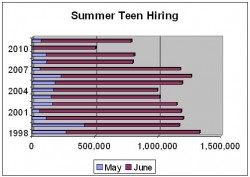
More teenagers found summer jobs in June than at any time since 2007.
Global outplacement firm Challenger, Gray & Christmas says June saw 785,000 16-19 year-olds hired. Last year, 457,000 teens got jobs in June.
Considering the summer hiring season for teenagers to be May through July, the two-month total of 785,000, well ahead of last year at this point, is shy of 2009’s 809,000. July’s numbers historically are about half of June’s. But last year, July’s hiring was almost as large as June’s, a consequence, perhaps, of employers wanting to be sure they had the customers to support the summer staff.
July’s numbers won’t be known until August 5th when the U.S. Bureau of Labor Statistics releases its next monthly employment report. So far, no one is making predictions about what it will show. The June report had the economy adding only 18,000 new jobs, a number that surprised even the most pessimistic economists.
(Note: If you’re a data wonk, you may have noticed that the jobs numbers I’ve used here are contradictory. That’s explained at the end of this post.)
Even if there is a surge of summer hiring, most teenagers won’t have jobs. For the vast majority, that’s by choice. According to the BLS, there are 10 million kids not in the labor force. These are the kids who will populate America’s summer camps, summer schools, beaches, malls, parks, and streets.
Some will hold unpaid internships. NACE, the National Association of Colleges and Employers, said last week that half the Class of 2011 had at least one internship before graduation. Many — 37 percent, according to the survey — worked for free.
Among the 20,000 respondents to the NACE survey, paid interns spent more time on professional tasks while unpaid interns were more likely to perform clerical work. As a result, the paid intern “may offer employers more of the type of experience they’re seeking in their new hires,” says Marilyn Mackes, NACE executive director.
For employers, unpaid internships can be a benefit and a headache. State, and especially federal labor rules require employers offering unpaid internships to provide training, feedback, and to comply with regulations regarding hours, and breaks. The U.S. Department of Labor and many states (California, for example) strongly prefer that unpaid internships be managed by or at least in conjunction with a school or college and that credit be offered.
Even were these jobs to abound, it’s unlikely there would be enough to go around. The BLS reported there were 1.86 million teens in June who wanted a job and actively looked for work during the month. That translates into an unemployment rate for 16-19 year-olds of 27.6 percent. The unadjusted unemployment rate for the population as a whole was 9.3 percent. (The seasonally adjusted rate was 9.2 percent.)
For black teenagers, the unemployment rate was 45 percent. White kids had an unemployment rate of 24.8 percent. Teenage women of all races fare better than men. Their unemployment rate is 25.6 percent to 29.5 percent for men.
(Note: Challenger, Gray & Christmas and I are using the unadjusted jobs numbers. The monthly numbers economists, investors, and others focus on are seasonally adjusted numbers. In most cases, removing some of the seasonality offers a clearer picture of what’s happening in the overall economy. But using seasonally adjusted numbers to see how teenagers are faring would distort the picture, since we’re talking summer jobs.)